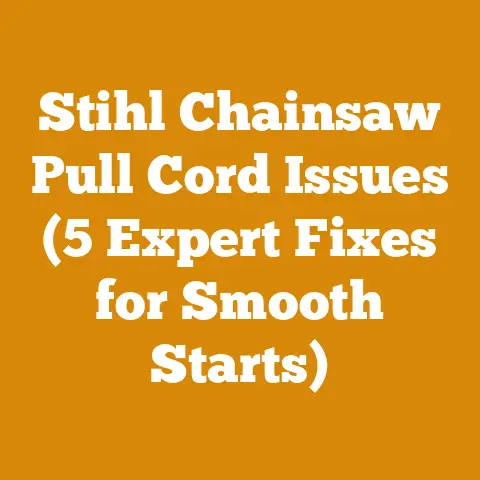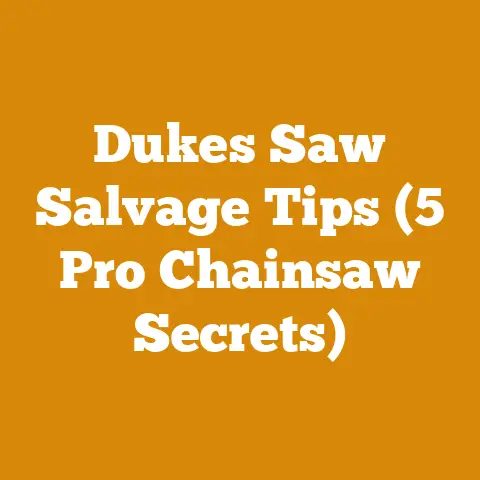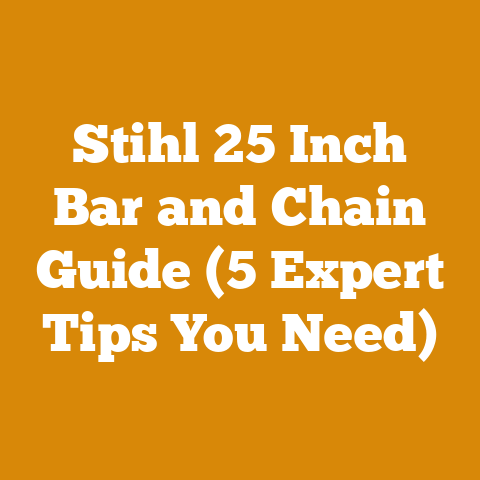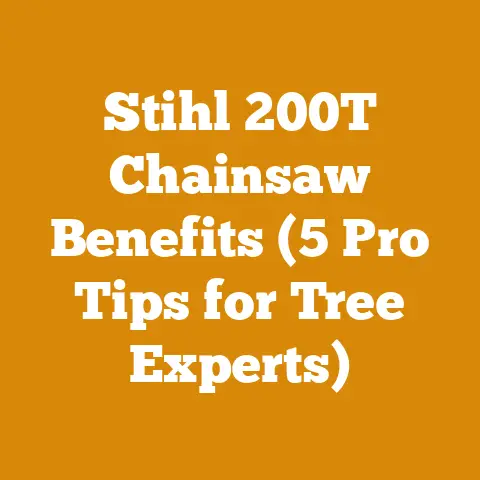Tree Removal Stump Grinding Cost (5 Pro Tips for Accurate Pricing)
Have you ever stood in your yard, gazing up at a towering tree, its branches intertwined with the sky, and felt a pang of… well, maybe not sadness, but a certain responsibility?
Perhaps it’s diseased, or maybe it’s simply outgrown its welcome, threatening power lines or the foundation of your home.
The decision to remove a tree, especially a large one, is never easy.
But the real challenge begins when you start thinking about the aftermath: that unsightly stump.
And then comes the question that sends shivers down the spine of any homeowner: “How much is this going to cost?”
I remember the first time I had to deal with a tree removal and stump grinding.
It was an old oak in my backyard, a majestic giant that had unfortunately succumbed to oak wilt.
The tree removal itself was a spectacle, a team of professionals with ropes and chainsaws performing a delicate dance of destruction.
But the stump… that was a different beast altogether.
I naively thought I could just dig it out myself.
Let’s just say my back protested vehemently, and I quickly learned that stump grinding was the only viable option.
The quotes I received were all over the map, and frankly, quite confusing.
That’s when I realized I needed to understand the underlying factors that contribute to tree removal and stump grinding costs.
That experience led me down a rabbit hole of research, talking to arborists, landscapers, and even some seasoned loggers.
This article is born out of that experience.
It’s designed to equip you with the knowledge you need to navigate the often-murky waters of tree removal and stump grinding pricing.
I’ll share my insights, along with data-backed information and practical tips, to help you get accurate quotes and avoid any financial surprises.
Let’s dive in.
Tree Removal & Stump Grinding Cost: 5 Pro Tips for Accurate Pricing
The cost of tree removal and stump grinding is anything but straightforward.
It’s a complex equation with multiple variables, each capable of significantly impacting the final price.
Before you even think about calling for quotes, it’s crucial to understand these factors.
1. Understand the Core Cost Drivers: Size, Species, and Accessibility
These three factors are the holy trinity of tree removal and stump grinding costs.
They’re the foundation upon which everything else is built.
Size Matters: This is the most obvious factor.
A towering 80-foot oak will cost significantly more to remove than a small 20-foot ornamental tree.
The larger the tree, the more labor, equipment, and time are required.
This directly translates to higher costs.
Stump grinding is also affected by size, as a larger stump requires more grinding time and potentially a larger, more powerful grinder.- Data Point: According to a survey conducted by HomeAdvisor, the average cost of tree removal ranges from \$150 to \$2,000, with the majority of homeowners paying between \$400 and \$1,000.
However, this range is incredibly broad.
The size of the tree is the single biggest determinant within that range. -
Species Specifics: The type of tree also plays a significant role.
Hardwoods like oak, maple, and ash are denser and more difficult to cut and grind than softwoods like pine, fir, and spruce.
This difference in density translates to increased labor and equipment wear, driving up the cost.
Some species also have more extensive root systems, making stump grinding more challenging. -
Personal Story: I once had to remove a silver maple that had aggressively spread its roots under my patio.
The stump grinding process was significantly more expensive than I had anticipated because the roots kept extending far beyond the visible stump. -
Accessibility is Key: This is where things can get tricky.
If the tree is easily accessible, with no obstacles like fences, power lines, or buildings, the removal process will be relatively straightforward.
However, if the tree is located in a tight spot, requiring specialized equipment or manual labor, the cost will increase significantly.
Similarly, if the stump is difficult to access with a grinder, the price will reflect the added complexity. -
Example: A tree located on a steep slope or behind a house with a narrow gate will be more expensive to remove than a tree in an open field.
- Data Point: According to a survey conducted by HomeAdvisor, the average cost of tree removal ranges from \$150 to \$2,000, with the majority of homeowners paying between \$400 and \$1,000.
Actionable Takeaway: Before you start getting quotes, take a good look at the tree and its surroundings.
Assess its size, identify the species, and carefully consider the accessibility.
The more information you can provide to the arborists, the more accurate their quotes will be.
2. Unveiling Hidden Costs: Permits, Debris Removal, and Root Removal
Beyond the core cost drivers, there are several “hidden” costs that can significantly impact the final price.
Failing to account for these can lead to unpleasant surprises down the road.
Permits and Regulations: Many municipalities require permits for tree removal, especially for large or protected trees.
The cost of these permits can vary widely, from a few dollars to several hundred dollars.
It’s crucial to check with your local authorities to determine if a permit is required and what the associated fees are.- Warning: Removing a tree without a permit can result in hefty fines, so it’s always best to err on the side of caution.
-
Debris Removal: After the tree is removed and the stump is ground, there will be a significant amount of debris to deal with.
This includes branches, logs, wood chips, and other organic matter.
The cost of debris removal can vary depending on the volume of debris and the disposal method.
Some companies include debris removal in their initial quote, while others charge extra. -
Cost Optimization: Ask the arborists about their debris removal options.
You may be able to save money by handling the debris removal yourself, especially if you have a wood chipper or a way to dispose of the debris properly. -
Root Removal Beyond Grinding: Stump grinding typically addresses the visible portion of the stump and the immediately surrounding roots.
However, if you want to completely remove the entire root system, it will require additional excavation and labor.
This can significantly increase the cost, especially for trees with extensive root systems. -
Consider Your Needs: Do you need to completely remove the entire root system?
If you’re planning to build on the area, then it may be necessary.
However, if you’re just planting grass or shrubs, you may be able to get away with just grinding the stump and the immediate roots.
Actionable Takeaway: Ask the arborists about permits, debris removal, and root removal options.
Make sure you understand exactly what is included in their quote and what additional costs you may incur.
3. Labor Costs: The Human Element in Tree Removal and Stump Grinding
Labor costs are a significant component of tree removal and stump grinding expenses.
These costs reflect the expertise, skill, and risk involved in these tasks.
Skilled Arborists vs.
General Landscapers: While a general landscaper might offer a lower price, it’s crucial to hire a certified arborist for tree removal and stump grinding.
Arborists have the knowledge, training, and experience to safely and effectively remove trees and grind stumps, while minimizing the risk of damage to your property or injury to themselves.- Data Point: According to the International Society of Arboriculture (ISA), certified arborists have demonstrated a high level of knowledge and competence in tree care.
Hiring a certified arborist can help ensure that the job is done safely and professionally. -
Crew Size and Expertise: The size and expertise of the crew will also affect the labor costs.
A larger crew can complete the job more quickly, but it will also increase the labor expenses.
Similarly, if the job requires specialized skills, such as climbing or rigging, the labor costs will be higher. -
Insight: Ask the arborists about their crew size and the experience of their team members.
A well-trained and experienced crew can often complete the job more efficiently and safely, potentially saving you money in the long run. -
Hourly Rates vs.
Fixed Bids: Arborists typically charge either an hourly rate or a fixed bid for tree removal and stump grinding services.
Hourly rates can be unpredictable, as the total cost will depend on the amount of time it takes to complete the job.
Fixed bids provide more certainty, but it’s important to make sure that the bid includes all the necessary work, including permits, debris removal, and root removal. -
Recommendation: I generally prefer fixed bids, as they provide more transparency and predictability.
However, it’s important to carefully review the bid to make sure that it includes all the necessary work and that there are no hidden fees.
- Data Point: According to the International Society of Arboriculture (ISA), certified arborists have demonstrated a high level of knowledge and competence in tree care.
Actionable Takeaway: Prioritize hiring a certified arborist with a skilled and experienced crew.
Ask about their pricing structure and make sure you understand exactly what is included in their quote.
4. Equipment Costs: From Chainsaws to Stump Grinders
The equipment used in tree removal and stump grinding can be expensive, and these costs are factored into the overall price.
Chainsaws and Safety Gear: Chainsaws are the workhorses of tree removal.
Arborists use a variety of chainsaws, from small handheld saws to large, powerful saws for felling trees.
They also use a variety of safety gear, including helmets, eye protection, ear protection, and chainsaw chaps.
The cost of these tools and equipment is factored into the labor rates.- Unique Insight: The quality of the chainsaws and safety gear can significantly impact the efficiency and safety of the tree removal process.
Arborists who invest in high-quality equipment are often able to complete the job more quickly and safely, potentially saving you money in the long run. -
Stump Grinders: The Star of the Show: Stump grinders are specialized machines designed to grind stumps into small wood chips.
There are different types of stump grinders, ranging from small, portable grinders to large, self-propelled grinders.
The cost of the stump grinder will depend on its size and power. -
Global Perspective: In some parts of the world, stump grinding is less common, and other methods, such as burning or chemical removal, are used.
However, in most developed countries, stump grinding is the preferred method, as it is relatively quick, efficient, and environmentally friendly. -
Rental vs.
Ownership: Some arborists own their equipment, while others rent it.
If the arborist rents the equipment, the rental costs will be passed on to you. -
Question to Ask: Ask the arborists if they own or rent their equipment.
This can give you some insight into their overhead costs and their pricing structure.
- Unique Insight: The quality of the chainsaws and safety gear can significantly impact the efficiency and safety of the tree removal process.
Actionable Takeaway: Understand the types of equipment used in tree removal and stump grinding.
This will help you appreciate the complexity of the job and the associated costs.
5. Location, Location, Location: Regional Price Variations and Seasonal Factors
The cost of tree removal and stump grinding can vary significantly depending on your location and the time of year.
Regional Price Differences: Labor costs, equipment costs, and permit fees can vary widely from region to region.
In general, tree removal and stump grinding are more expensive in urban areas than in rural areas.- Data Point: According to a survey conducted by Thumbtack, the average cost of tree removal in San Francisco is significantly higher than the average cost in Wichita, Kansas.
-
Seasonal Fluctuations: The demand for tree removal and stump grinding services typically peaks in the spring and fall, when homeowners are preparing their yards for the growing season or cleaning up after storms.
During these peak seasons, prices may be higher due to increased demand. -
Cost Optimization: If possible, try to schedule your tree removal and stump grinding during the off-season (winter or summer).
You may be able to get a lower price due to reduced demand. -
Travel Costs: If the arborist has to travel a significant distance to your property, they may charge extra for travel expenses.
-
Recommendation: Try to find an arborist who is located relatively close to your property.
This will minimize travel costs and potentially reduce the overall price.
Actionable Takeaway: Be aware of regional price differences and seasonal fluctuations.
Try to schedule your tree removal and stump grinding during the off-season and find an arborist who is located close to your property.
Beyond the Basics: Additional Considerations for Accurate Pricing
While the five pro tips above cover the major cost drivers, there are a few additional considerations that can further refine your understanding of tree removal and stump grinding costs.
Emergency Tree Removal
If a tree has fallen or is in imminent danger of falling, you may need to hire an arborist for emergency tree removal.
Emergency tree removal services typically cost more than scheduled tree removal services, as they require immediate response and often involve working in hazardous conditions.
- Safety First: In emergency situations, prioritize safety over cost.
It’s crucial to hire a qualified and experienced arborist who can safely remove the tree without causing further damage or injury.
Insurance Coverage
In some cases, your homeowner’s insurance may cover the cost of tree removal and stump grinding.
This is typically the case if the tree was damaged by a covered peril, such as wind, lightning, or fire.
- Check Your Policy: Review your homeowner’s insurance policy to determine if tree removal and stump grinding are covered.
If you’re not sure, contact your insurance agent for clarification.
DIY Stump Removal Options (Proceed with Caution)
While I generally recommend hiring a professional for stump grinding, there are some DIY stump removal options that you can consider, such as:
- Manual Removal: This involves digging around the stump and cutting the roots with an axe or saw.
This is a labor-intensive process and is only suitable for small stumps. - Chemical Removal: This involves drilling holes in the stump and filling them with a chemical stump remover.
The chemical will gradually decompose the stump over time.
This process can take several months or even years. - Burning: In some areas, it may be permissible to burn the stump.
However, this is a risky process and should only be attempted by experienced individuals.
Warning: DIY stump removal options can be dangerous and time-consuming.
If you’re not comfortable with these methods, it’s best to hire a professional.
Budgeting for Tree Removal and Stump Grinding: A Practical Approach
Now that you understand the various factors that contribute to tree removal and stump grinding costs, let’s talk about how to create a realistic budget for your project.
- Assess Your Needs: Start by assessing your needs and priorities.
Do you need to completely remove the entire root system?
Are you willing to handle the debris removal yourself?
Are you on a tight budget? - Get Multiple Quotes: Contact at least three different arborists and get detailed quotes.
Make sure the quotes include all the necessary work, including permits, debris removal, and root removal. - Compare Quotes Carefully: Don’t just focus on the bottom line.
Compare the quotes carefully and consider the experience, qualifications, and reputation of the arborists. - Negotiate Prices: Don’t be afraid to negotiate prices.
Arborists are often willing to negotiate, especially during the off-season. - Set a Realistic Budget: Based on the quotes you receive, set a realistic budget for your project.
Be sure to factor in any potential unexpected costs.
Case Studies: Real-World Examples of Tree Removal and Stump Grinding Costs
To further illustrate the concepts discussed in this article, let’s take a look at some real-world examples of tree removal and stump grinding costs.
- Case Study 1: Small Tree Removal and Stump Grinding: A homeowner in a suburban area needed to remove a small 20-foot ornamental tree and grind the stump.
The tree was easily accessible, and no permits were required.
The total cost of the project was \$350. - Case Study 2: Large Tree Removal and Stump Grinding: A homeowner in a rural area needed to remove a large 80-foot oak tree and grind the stump.
The tree was located in a difficult-to-access area, and a permit was required.
The total cost of the project was \$2,500. - Case Study 3: Emergency Tree Removal and Stump Grinding: A homeowner in an urban area needed to remove a fallen tree and grind the stump after a storm.
The tree was blocking the driveway, and emergency services were required.
The total cost of the project was \$3,000.
These case studies illustrate the wide range of costs associated with tree removal and stump grinding.
The actual cost of your project will depend on the specific factors involved.
Formulas and Calculations: Estimating Wood Volume and Drying Time (Relevant for Debris Management)
While the primary focus is on removal costs, understanding the potential volume of wood generated and its drying time can be helpful if you plan to repurpose the wood instead of paying for removal.
- Estimating Wood Volume (Board Feet): A rough estimate for a standing tree involves estimating the merchantable height (height of the trunk usable for lumber) and the average diameter.
A simplified formula is:Board Feet ≈ (Diameter in Inches - 4) * (Height in Feet / 4).
This is highly approximate but gives a sense of the potential wood volume. - Estimating Firewood Drying Time: Drying time depends on wood species, initial moisture content, and climate.
A general rule of thumb is that firewood needs to dry for at least 6 months.
Hardwoods like oak typically take longer to dry than softwoods like pine.
A rough estimate for moisture content reduction is about 1-2% per week under good drying conditions (sunny, windy, stacked properly).
Ideal moisture content for firewood is below 20%.
Industry Benchmarks and Statistical Data
Here’s a summary of key industry benchmarks and statistical data to keep in mind:
- Average Tree Removal Cost: \$400 – \$1,000 (HomeAdvisor)
- Average Stump Grinding Cost: \$75 – \$400 (HomeAdvisor)
- Certified Arborist Hourly Rate: \$75 – \$150 (Estimate)
- Average Price per Cord of Firewood: Varies widely by region, but typically ranges from \$200 – \$400 (Local Market Research)
Idioms and Expressions for a Global Audience
To make this article more relatable to a global audience, here are a few idioms and expressions that can be used:
- “Cut to the chase”: Get straight to the point.
- “Barking up the wrong tree”: Pursuing the wrong course of action.
- “A penny saved is a penny earned”: Frugality is valuable.
- “The proof is in the pudding”: The value of something can only be determined after it has been tried.
Actionable Takeaways and Next Steps
By now, you should have a much clearer understanding of the factors that influence tree removal and stump grinding costs.
Here are some actionable takeaways and next steps to help you plan your project:
- Assess your needs and priorities.
- Get multiple quotes from certified arborists.
- Compare the quotes carefully and negotiate prices.
- Set a realistic budget and stick to it.
- Consider the timing of your project to take advantage of off-season discounts.
Removing a tree and grinding the stump can be a significant investment, but with careful planning and a little bit of knowledge, you can get the job done safely, effectively, and within your budget.
Don’t let the thought of the cost scare you off.
With the right information and a proactive approach, you can tackle this project with confidence.
And who knows, maybe you’ll even learn a thing or two about trees along the way!






